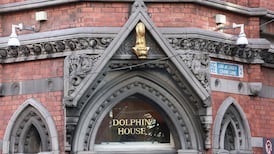A Garda Chief Superintendent told a murder trial jury on Thursday that he retrieved clothing from the home of a Dublin man accused of murdering two women in sheltered accommodation 18 years ago.
The prosecution has claimed DNA evidence recovered from a jacket provided “a spectacular breakthrough” in the case.
Mark Nash (42), who has last addresses at Prussia Street and Clonliffe Road in Dublin, has pleaded not guilty at the Central Criminal Court to the murder of Sylvia Shields (60) and Mary Callanan (61) between March 6th and March 7th, 1997.
Chief Supt Dominic Hayes, who held the rank of detective sergeant at the time and was attached to the National Bureau of Criminal Investigation (NBCI) at Harcourt Square in 1997, went to Beaumont Hospital on the morning of August 16th, 1997, to get a statement from Sarah Jane Doyle.
Serious assault
Ms Doyle had head injuries after being the victim of a serious assault in a house in Ballintober, Castlerea, Co Roscommon.
Chief Supt Hayes told the jury of six men and five women that Ms Doyle’s head was bandaged and she was in pain, so he agreed to come back later that night.
At about 8pm, a statement was given by Ms Doyle to Chief Supt Hayes where she gave permission for him to enter a flat she shared at the time with the accused, Mark Nash, on Clonliffe Road in Drumcondra, Dublin 3.
The court heard on August 17th, 1997, Chief Supt Hayes went to the flat with Det Garda Clayton to get a black pin-striped velvet jacket.
The two men were let into the property by the landlord and while there they seized a black pin-striped velvet jacket, one pair of black caterpillar boots, another pair of boots and a suit.
Chief Supt Hayes told the court that on the morning of August 18th, 1997, he travelled to the Forensic Science Laboratory, at Garda HQ in the Phoenix Park, and handed the items over to Dr Fiona Thornton.
The black pin-striped velvet jacket is of relevance as the court previously heard from Brendan Grehan SC, opening the prosecution’s case on January 22nd last, how in July 2009 “a spectacular breakthrough” was made in relation to the black velvet jacket with new tests, and how DNA belonging to Ms Shields and Ms Callanan was found on it.
During cross-examination on Thursday, Hugh Hartnett SC for the accused said to Chief Supt Hayes: “When there you seized boots, no consent was given for the boots.”
Big boots
“When I was there I saw boots and thought it was of relevance. There were two pairs of big boots and they can be a rich area of forensic evidence, and for that reason I took them,” replied Chief Supt Hayes.
“Did you know Detective Superintendent Gallagher was in Galway at that time, making enquiries about boots, is that a coincidence?” asked Mr Hartnett.
“Yes. I had no contact with Detective Superintendent Gallagher when he was down there,” replied Chief Supt Hayes.
The court also heard from retired detective Dominic Cox, who was appointed the exhibits officer in relation to the murders.
He told the court he retained the exhibits in secure storage in Bridewell Garda station until October 2003.
Under cross-examination from Mr Hartnett, Mr Cox said he got the boots in November 1997 from the technical bureau.
The court heard the jacket was never mentioned to Mr Cox and he was never asked to put the jacket into the exhibits locker - the boots were all he was dealing with.
Mr Cox told the court there was no interference with exhibits and in 2003 he handed the keys to now retired Det Garda Alan Bailey.
Sheltered accommodation
Mr Bailey was then cross-examined by Mr Hartnett regarding Martin Stafford, a criminal and suspect for the 1997 double murder of the two women who lived in sheltered accommodation in Grangegorman.
Mr Bailey told the court that Stafford was “one of 250 people who were persons of interest”.
Mr Hartnett put it to Mr Bailey that Stafford “was a person of particular interest” as he had hijacked a car on March 6th 1997 and assaulted a prostitute on the same day where he drove after her in a car, then proceeded to jump out of his car, grab her from behind in the middle of road and tried to put his arms around her.
With Stafford’s car spotted and identified “very close” to the murder scene at Orchard View in Grangegorman, Mr Hartnett asked Mr Bailey if this made him suspicious.
“Yes” replied Mr Bailey.
“He must have been a person of acute interest to the investigation?” Mr Hartnett put it to Mr Bailey.
“Yes, to a certain extent. We seized the car he had been seen driving that night. It was technically examined and there was nothing to link the car to the scene at Grangegorman,” replied Mr Bailey.
“Was that the end of it?” asked Mr Hartnett.
“If we believed the person in the car was involved in Grangegorman, there would have to have been certain traces of blood. We based how we dealt with this person on what we found in the car,” said Mr Bailey.
The trial continues.








